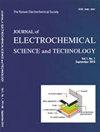Enhancement of Quick-Charge Performance by Fluoroethylene Carbonate additive from the Mitigation of Electrode Fatigue During Normal <i>C</i>-rate Cycling
IF 3
4区 工程技术
Q3 ELECTROCHEMISTRY
Journal of electrochemical science and technology
Pub Date : 2023-09-15
DOI:10.33961/jecst.2023.00661
引用次数: 0
Abstract
The quick-charging performance of SiO electrodes is evaluated with a focus on solid electrolyte interphase (SEI)- reinforcing effects. The study reveals that the incorporation of fluoroethylene carbonate (FEC) into the SiO electrode significantly reduced the electrode fatigue, which is from the the viscoelastic properties of the FEC-derived SEI film. The impact of FEC is attributed to its ability to minimize the mechanical failure of the electrode caused by additional electrolyte decomposition. This beneficial outcome arises from volumetric stain-tolerant characteristics of the FEC-derived SEI film, which limited exposure of the bare SiO surface during 0.5 C-rate cycling. Notably, FEC greatly improves Li deposition during quick-charge cycles following aging at 0.5 C -rate cycling due to its ability to maintain a strong electrical connection between active materials and the current collector, even after extended cycling. Given these findings, we assert that mitigating SEI layer deterioration, which compromises the electrode structure, is vital. Hence, enhancing the interfacial attributes of the SiO electrode becomes crucial for maintaining kinetic efficiency of battery system.氟碳酸乙烯添加剂在正常<i>C</i>倍率循环过程中对电极疲劳的缓解提高了快充性能
本文章由计算机程序翻译,如有差异,请以英文原文为准。
求助全文
约1分钟内获得全文
求助全文
来源期刊

Journal of electrochemical science and technology
ELECTROCHEMISTRY-
CiteScore
6.30
自引率
8.10%
发文量
44
期刊介绍:
Covering fields:
- Batteries and Energy Storage
- Biological Electrochemistry
- Corrosion Science and Technology
- Electroanalytical Chemistry and Sensor Technology
- Electrocatalysis
- Electrochemical Capacitors & Supercapcitors
- Electrochemical Engineering
- Electrodeposition and Surface Treatment
- Environmental Science and Technology
- Fuel Cells
- Material Electrochemistry
- Molecular Electrochemistry and Organic Electrochemistry
- Physical Electrochemistry
- Solar Energy Conversion and Photoelectrochemistry
 求助内容:
求助内容: 应助结果提醒方式:
应助结果提醒方式:


